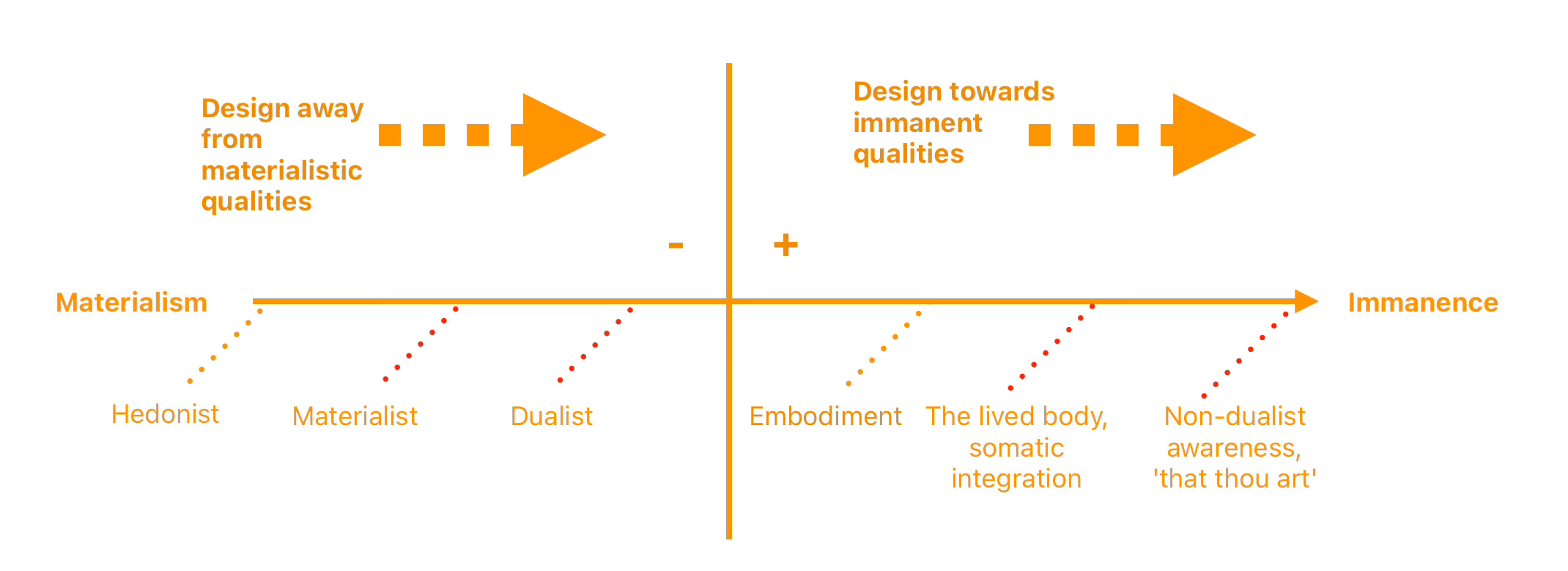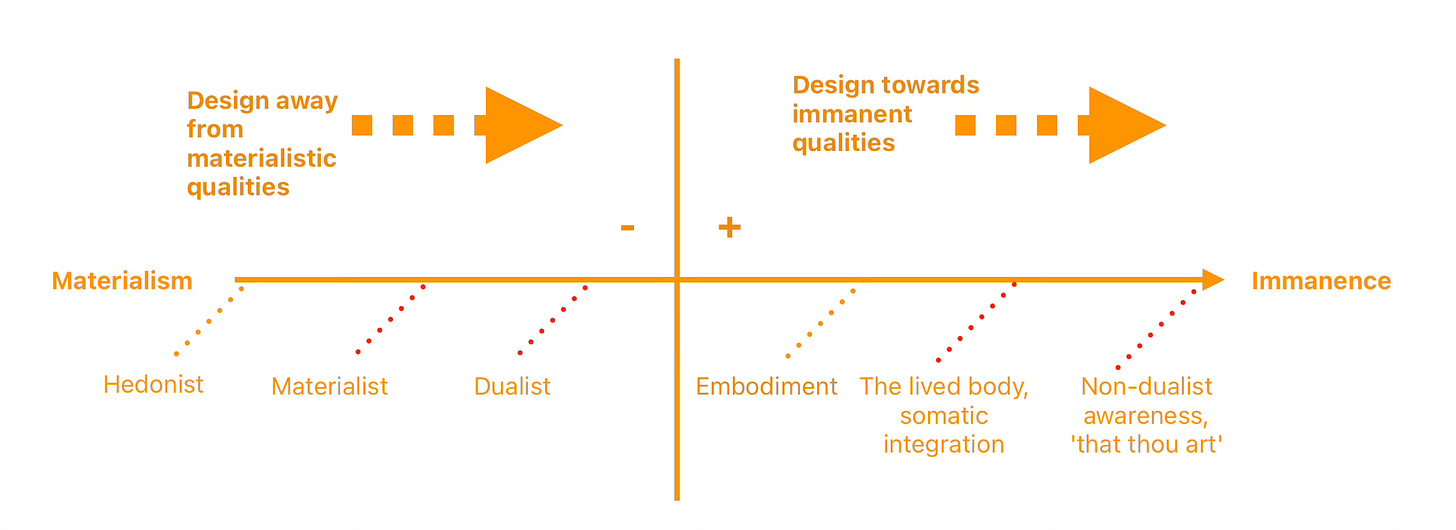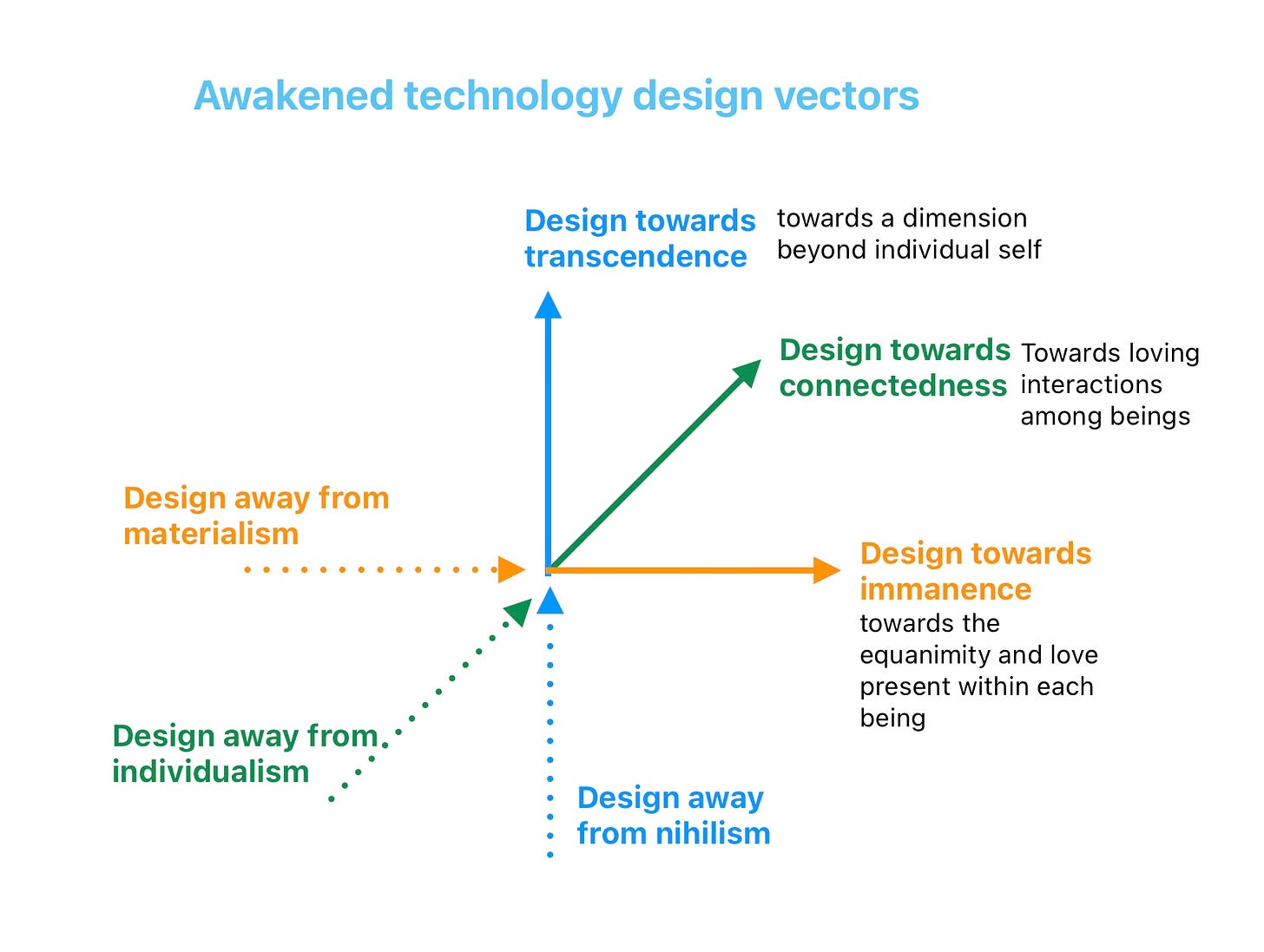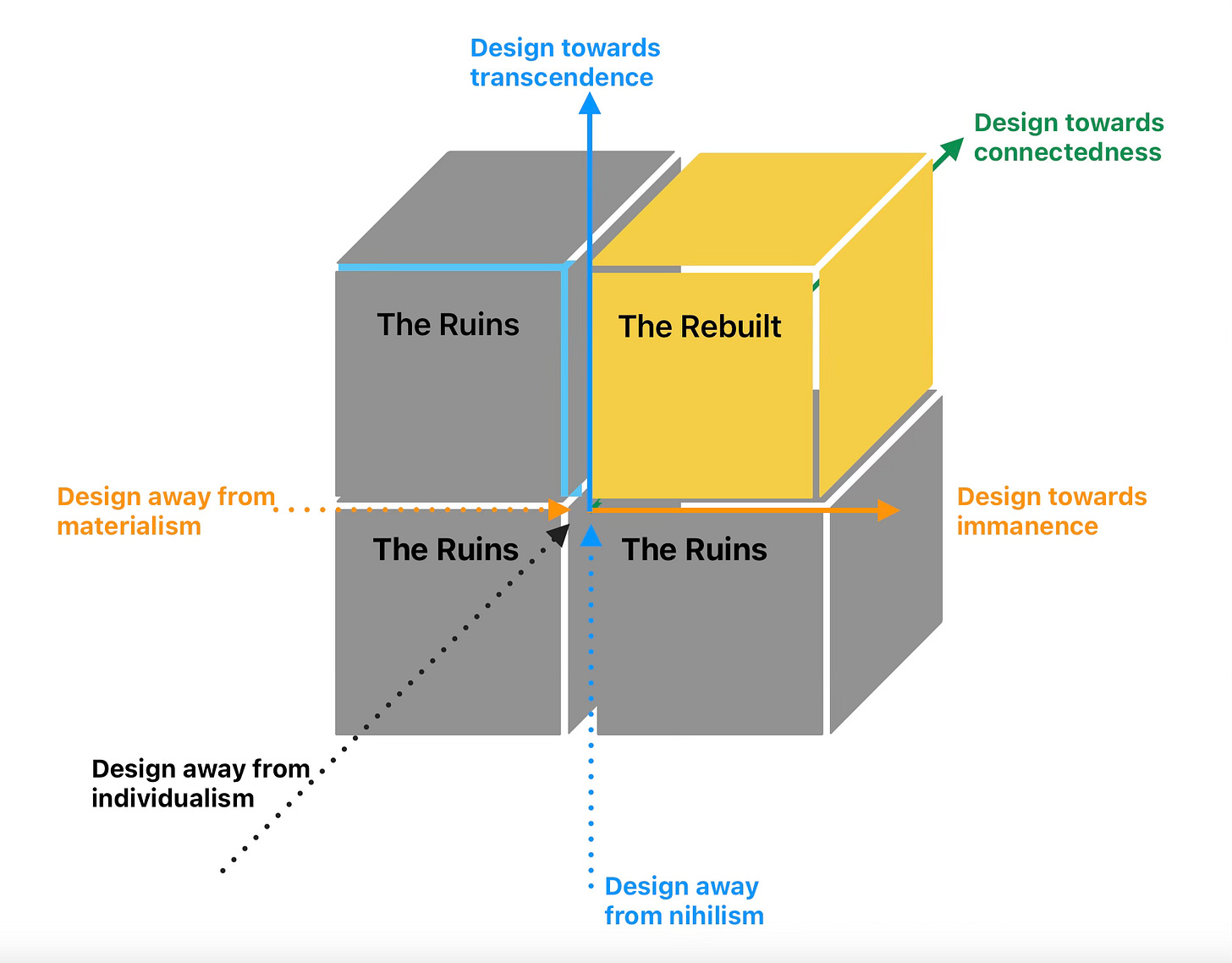What would immanent technology design look like?
Immanence: the X axis where technology and spirituality can meet
This is the third in the series of posts where I explore the conceptual intersections of technology and spirituality for practical purposes. The first, introductory post, covered Professor Gabriel Fernandez-Borsot’s premise, i.e. that the concepts of transcendence, immanence, and relationality can help us in reframing how we think about the ways that technology and spirituality relate to each other. In the second post, I unpacked the Y axis of transcendence, and now we’ll move on to the X axis, immanence.
Immanence and spirituality
Immanent refers to something “existing or operating within; inherent” or something “present within each being or entity”. Accordingly, what is spiritual in an individual rises from within, encompassing both the body and the mind and surpassing the division.
As a reminder, spirituality can be thought of as the experience of being connected to something beyond our individual selves and adopting practices that cultivate that relationship. When we build and use technology to extend our agency or to manipulate nature, is there a spiritual aspect to it? I suggest, in current dominant design, engineering, and everyday consumption practices, there isn’t.
The practical question then becomes: how could a sense of connectedness to something greater than ourselves, i.e. something spiritual - arising from within - inform technological development? And, how might we consume technology in ways that are more alike to what is immanent in us?
I wrote in the previous part of this series about how such aspirations need to focus on the process of building technology rather than its concrete outputs. Or, to how we choose to spend our attention as consumers of technology. I propose that any move towards an awakened design or perception of technology needs to focus on the processes of making it and consuming it, rather than striving for technologies that are somehow spiritual in their material existence. We can (and should) make more sustainable and responsibly sourced smartphones, but attempting to create a spiritual smartphone would be ludicrous — it would only work in a significantly transformed world, not in the world as we know it.
Yet, we can be aspire for an awakened mindset in making future communication devices, with the idea that the end products would better reflect our immanent — inherently loving and peaceful — nature. Ideally, they would also reflect our transcendental aspirations (the previous post) and relational modes of knowing and being (forthcoming post, the final part of the series). As we will see, reflecting qualities from one of the axes brings about qualities from the others.
The immanent as embodied spirituality
With Unexamined Technology, in general, I promote non-dualism that does not see the body and the mind, or any human experience and the ‘experiencer’ as separate. What does that mean in practice? It enables one to think about our awareness as the ground of being, as a continuous space that both connects individual beings and objects but reaches beyond them, making individualism appear groundless and unhelpful. Therefore, immanence is at once singular and multiple — what arises in you also arises in me, it’s just that what is immanent in you as an excitation centres on what you perceive as the self.
Immanence is closely tied to transcendence in theological and philosophical thought. Rupert Spira talks about how we can become to understand awareness itself as something that pervades all knowledge and experience, yet such acknowledgment “is to recognise the transcendent nature of awareness but not its immanence.” He elaborates:
If we do not reintegrate this understanding with our objective experience, then a fragile alliance will persist between our essential, irreducible nature of pure awareness and all objects and others. This often manifests as a denial or rejection of embodied life in the world and may readily become a refuge for any lingering sense of a separate self. - Rupert Spira, Being Aware of Being Aware.
Nevertheless, at times the body-mind distinction is conceptually useful in highlighting how the dualism leads to an imbalance that needs addressing. In Gabriel Fernandez-Borsot’s three-fold reflection on technology and spirituality, investigation on the immanent axis is about the relationship between technologies and our bodies. We use technologies to extend our human capabilities, or to enhance our sense impairments, such as correcting vision with eyeglasses. How does technology as a prosthesis relate to spirituality? Fernandez-Borsot writes:
The immanent axis of spirituality points to the idea that the source of spirituality lies within each entity. Thus, from an immanent perspective, beings and things do not receive their spiritual aliveness from outside, but rather such aliveness arises from within. In the human being, spiritual immanence implies the recognition of the sacredness of the body and the energetic and transformative potentials that lie in the somatic ground: immanent spirituality is embodied spirituality. - Spirituality and technology: a threefold philosophical reflection, p. 13.
Immanent as an aspirational quality of technology is about the embodied ways that technologies engage us into introspective somatic practices, whether we are in the process of designing and developing technologies or consuming them. But, with our digital, disembodied, ephemeral tools and devices, to what extent does that even happen any more? We are ‘building’ technologies in a metaphorical sense, mostly. The majority of us who are, or have been, fascinated by technology, do not put our hands in the soil or lay one brick over another.
The physical body and the lived body
In the philosophical tradition of phenomenology, thinkers such as Edmund Husserl and Maurice Merleau-Ponty established the distinction between the physical body and the lived body — the former being our biological body that is treated by medicine, and the latter consisting of our embodied experiences.
Fernandez-Borsot (p. 15-16) suggests that prosthetic technologies fail to bring the mind and body together. Either one or the other is privileged. For example, aspirations about the possibility to upload our mind to the cloud discounts the physical body, while ‘biohacking’ body parts discounts the lived experience of the body. Both represent highly mechanistic ways of approaching our bodies and minds.
Fernandez-Borsot cites philosophers of technology such as Jacques Ellul to discuss how technologies overwhelm the lived body and detach it from the organic rhythms of life, leading to various forms of restlessness. While the nervous energy of such restlessness can be channelled into innovating technological solutions that bring positive change, such as medicine, for the majority of us, restlessness generates stress and suffering.
As a consequence, technological solutions to extend, enhance, or engineer the body — as they currently stand — tend to disconnect from the immanent dimension. They treat the immanent as a lack rather than an inherent strength; they are incapable of cultivating our spiritual qualities.
The opportunity to foster a dialogue between technological and spiritual approaches is in balancing the divide between the physical and the lived body — somatic practices, such as yoga and Qigong, facilitate such integration. Technologies can inform the development of somatic spiritual practices, but they would need to be designed to support the emergence — or re-emergence, going back to building in a concrete sense — of immanent qualities. Spiritual practices in turn can reframe the technological mindset for it to better account for the complexities and diversities of our embodiment.
Designing towards immanence
Designing for, with, and through immanence begins with a mindset. It is a mindset aligned with the notion of critical technical awakening. It seeks to build technology and its applications away from numbing hedonism and materialism, from the disembodiment, and towards qualities that facilitate individual or collective inquiry, enable agency towards moral acts, and enable human and planetary flourishing.
Ultimately, designing towards immanence equals designs that strive for fostering the equanimity and peace present within each being. Only from such a space can the immanent arise, undisturbed by external material forces. In this way, the immanent can be seen to arise in unison with the transcendent.
The practical question is: How can one imbue such qualities into a product? It would have to be as a hypothesis to begin with, and through iteration and observation of how people use the product, trying to steer the output towards a fuller realisation of the immanent qualities.
I propose three positive coordinates for such aspirational design outcomes — coordinates that have their negative counterparts in mind-body dualism and what I see as regressive qualities that the counterparts potentially foster: an outlook on life that gravitates towards paying attention to material things and attaching to them and the feelings they invoke. Hedonism and avarice represent the heightened forms of such attachments.
The positive ones arise from non-dualism: first, acknowledging embodied forms of knowing, and then leading to the acceptance and somatic integration of the lived and physical body. Striving for the immanent can lead to accessing the ‘pure’ awareness that, e.g., the tradition of Advaita Vedanta suggests as the ground of being.
Ultimately, with these coordinates I propose a path along which one can aspire to progress along the axis of immanent qualities, both in everyday life but in the context of our relationship with technology in particular (and that division is a line drawn in sand, which emphasises my point).
I realise the coordinates for immanence are abstract for design purposes, but I’d like to point out that today I am discussing them in isolation from the two other axes: transcendence and relationality (or connectedness) - see the image above. Making progress away from the negative space and towards the positive in one axis will nudge the others along.
Together, the axes make up an aspirational design space that I propose gives rise to more concrete design aspirations. Once I summarise the model in a future post, I will give more examples of such goals. As a teaser, the below image maps the awakened design space of rebuilding and regrowing, away from the negative space that is taking us towards the ruins of this civilisation.
Towards relations
With the next post, I will complete the picture with the axis of relationality — or connectedness, a term that I find more accessible. The practical dimension of spirituality in terms of relations is caring about others and the environment. The idea is that humans flourish in relation to one another - a notion that is found in various wisdom traditions around the world, from Confucian to Ubuntu ethics. They all emphasise prosocial behaviour and how the essence of being human emerges from relationships to others instead of individualistic interests. Living by relations and relationality fosters a common ground of being and wisdom.
Thank you reading. As always, I leave you with a piece of algorithmic art:
With love and kindness,
Aki






